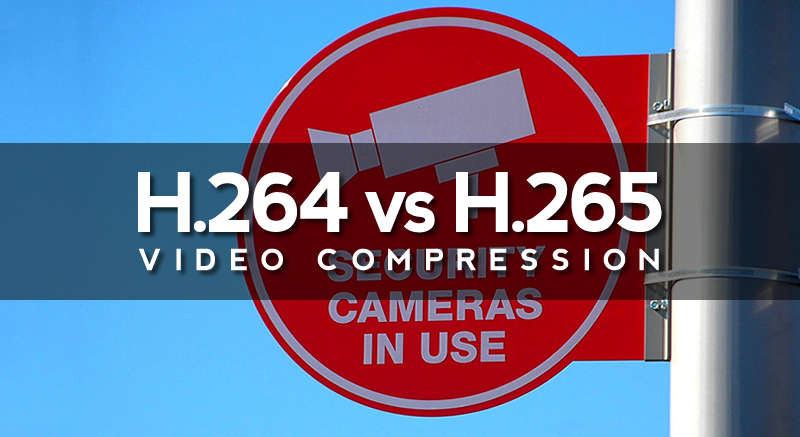In the H.264 vs H.265 debate, H.265 technology offers smart coding technology and intelligent face compression while H.264 had made advancements to optimize bitrates, reduce bandwidth, increase storage capacities, and maintain high video quality.
H.264 vs H.265 Video Compression Technology
Video compression technology has always been crucial in surveillance system designs since the 1990s thanks to the advent of Internet Protocol (IP). The need for video surveillance over IP has pushed video compression developments about every ten years.
Today, the H.265 High-Efficiency Video Coding is all the rage since it is the next iteration above H.264 that is presently dominating IP video encoding technology. Thanks to the high appetite for new and updated technology systems and the need to stay ahead of the curve due to steep market competition, the H.265 video coding will soon surpass H.264.
What is H.265?
H.265 is a high-efficiency video coding technology that has the capability of doubling the compression efficiency of H.264. What this means is that H.265 uses only half the bitrate otherwise used by H.264 when transmitting images of a specific quality. Ergo, H.265 significantly reduces the storage and bandwidth requirements during video encoding, which is highly beneficial for both software and hardware usage.
In a nutshell, you can do more with less, which is why many security hardware manufacturers support the development and introduction of H.265 high-efficiency video coding in the industry. Unfortunately, despite its apparent benefits, H.265 is quite far off from mass adoption due to recent improvements of the H.264 technology that has made it possible to reduce storage requirements by a whopping 75 percent. These developments will see the co-existence of the two technology standards for the next several years but make no mistake, H.265 is the standard for the near future.
Impediments to the Mass Adoption of H.265
As mentioned above, improvements in the H.264 video compression standard; specifically in three areas namely predictive encoding, long-term bitrate control, and noise suppression; coupled with other factors such as the high cost of upgrading to H.265 are all significant impediments to its industry-wide adoption. These are discussed in detail below:
1. H.264 Improvements
Security systems manufacturers have made significant advancements in the H.264 codec to optimize bitrates as well as reduce bandwidth and storage capacities while maintaining high video quality. These H.264 advancements have significantly reduced the need and demand for H.265 encoding technologies. These improvements include:
Predictive Encoding: Optimized H.264 technologies are capitalizing on the fact that users are more concerned about a scene’s moving objects as opposed to the stagnant background. Thus, these stagnant backgrounds are encoded as reference frames, which reduces bitrate usage saving encoding systems a lot of storage and bandwidth.
Long-Term Bitrate Control: Since a scene’s bitrate requirements fluctuate over the course of a certain period, say one day, advanced H.264 technologies manage this variance by calculating the overall average bitrate of an hour and automatically allocating the required bitrate at the right time of the day. This long-term bitrate control allows you to predict your video storage requirements with accuracy.
Noise Suppression: Unwanted electrical signals in a video feed, or ‘noise,’ is caused by fluctuations in temperature, light, and other signals in the air. Optimized H.264 technologies use intelligent analysis algorithms to suppress most of this noise by encoding foreground image subjects at a higher bitrate compared to background images.
2. Limitations of Laboratory Testing
Tests done by JCT-VC (or the Joint Collaborative Team on Video Coding) has shown that H.265 has doubled the compression rate of H.264. However, these tests were done in a laboratory setting and are unproven and untested in the real world. This means that compared to the tested and proven compression capabilities of H.264 in the real world, H.265 may not reach its advertised 100 percent improvement over H.264 in actual application.
3. High Patent Cost
While the H.264 patent has wide-spread enterprise ownership, which makes it easy and affordable to acquire, H.265 is in its early stage of existence meaning that its owner enterprises are not unified on many issues including its cost. Its high patent price tag plus the cost of replacing both back-end and front-end systems may make it quite a costly affair for many companies.
H.264 vs H.265 : The Way Forward
Despite the above impediments to H.265’s widespread industry implementation, all the drawbacks are associated with early-stage technology developments. This means that the potential application advantages of H.265 will eventually outweigh its current impediments as characterized by the industry’s 10-year compression itch.
Video compression developments have followed a 10-year cycle as evidenced by the introduction of the MPEG2 in 1994, H.264 in 2003, and H.265 in 2013. The implementation of improved video encoding standards has historically reacted to changes in technology and industry trends from DVD (MPEG) to HD technology and mobile internet (H.264) to HD digital television, video surveillance, Blu-ray, and Internet video (H.265).
H.265 technology offers numerous advantages such as smart coding technology and intelligent face compression making it the next big thing in the video encoding space.
About DataStrait Networks
DataStrait Networks is the Upper Midwest leader in voice, data, and security infrastructure. By establishing a working alliance between manufacturers, engineers, architects, and contractors, DataStrait provides the products, services, expertise, and creativity necessary for constructing a reliable, high performance, communications network infrastructure in a fast and cost-efficient manner.
Established in 1996, DataStrait works within the Minnesota, North Dakota, South Dakota, Wisconsin, Indiana, and Illinois markets. Customers that leverage DataStrait's unique methodology include state-of-the-art stadiums, Fortune 500 corporate campuses, government entities, educational institutions, nonprofit organizations, and small businesses.

